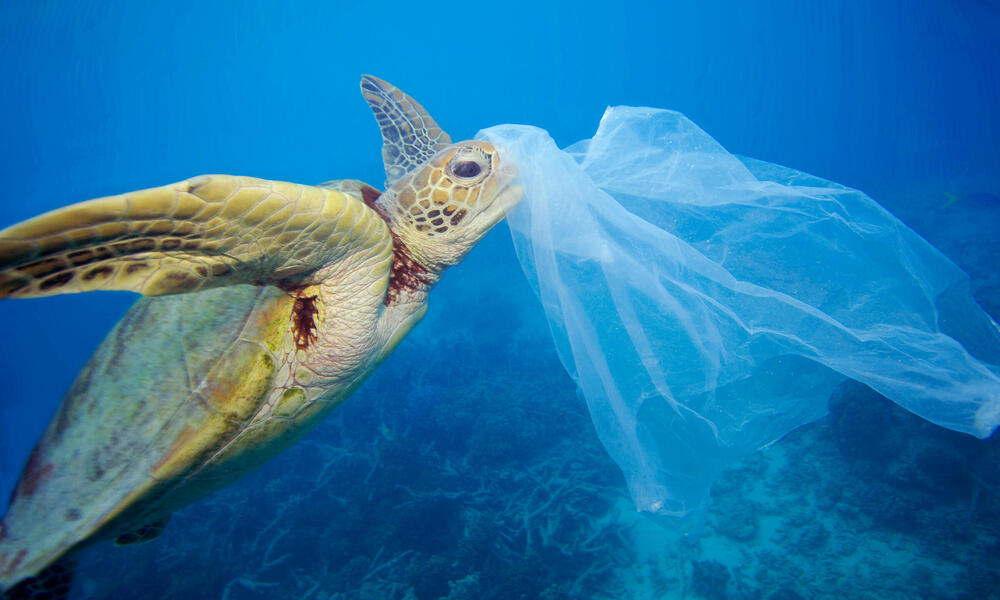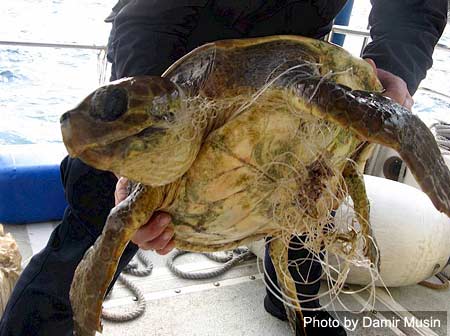An organization on the coast of Kenya tries to persuade local residents to help return the trapped reptiles to the ocean, rather than sell their meat and shells for a living.
A green sea turtle trapped in a gill net. Scientists estimate the global green turtle population has declined 50 to 70 percent since 1900.

WATAMU, Kenya — The young hawksbill turtle was accidentally caught in a net in the Indian Ocean off Kenya’s coast.
The fisherman called Local Ocean Conservation, a nonprofit based in the town of Watamu that is the only turtle rescue and rehabilitation center on the East African seaboard. The hawksbill, critically endangered in this region, was a mere seven pounds; adults can weigh up to 160 pounds.
X-rays showed that the reptile’s intestinal tract was clogged with plastic. Hogaar, as Local Ocean named her, floated and couldn’t dive. Gas had built up in her innards after she had eaten small pieces of plastic mistaken for food such as jellyfish. Local Ocean staff members placed Hogaar in a rehab pool and gave her laxatives. She passed feces laced with shreds of packaging and had little appetite. After more than four months at Local Ocean, Hogaar died. A necropsy revealed her gut was also full of sharp shards of white, blue and pink plastic and tangles of blue and gray string.
Turtles are reptiles that have existed for at least 110 million years and survived the mass extinction that killed off dinosaurs. But today, sea turtles worldwide are threatened with extinction. And it’s estimated that only one of 1,000 turtle eggs laid survive to adulthood.
Worldwide, hawksbills are critically endangered, while green and loggerhead turtles are endangered, according to the International Union for Conservation of Nature. Olive ridleys and leatherbacks are vulnerable. All five species of these sea turtles are found in Kenyan waters. The global green turtle population has declined by an estimated 50 to 70 percent since 1900.
In a village near Watamu, Kenya, a sea turtle accidentally caught by a fisherman was turned over to Local Ocean Conservation.

Conservationists are trying to protect turtles from a wave of threats, including pollution. Since its founding in 1997, Local Ocean has protected about 1,000 nests, conducted more than 17,000 turtle rescues and treated more than 480 turtles in its rehab center. About 60 to 70 percent of turtles are released back in the ocean.
Ten to 15 percent of the center’s turtle patients are sick from eating plastic. Most of them do not survive. Spiky papillae lining turtles’ throats prevent them from regurgitating plastic. And surgery on gastrointestinal tracts is difficult to do if it requires breaking open their shells.

Because some turtles presumably die in the ocean, there is no reliable estimate of how many are harmed by plastics. But there is no doubt plastic pollution is growing; three-quarters of marine litter is now composed of plastic and tons of plastic waste get dumped into the ocean every year, according to a 2017 report from the United Nations Environment Assembly.
An obscene rainbow of plastic debris washes up on Kenya’s beaches, drifting there from as far away as Madagascar and Malaysia according to labels still legible on items. Local Ocean’s volunteers collect the garbage, in sacks bulging with plastic lids, bottles, toothbrushes, yogurt cups, food packaging and more.
